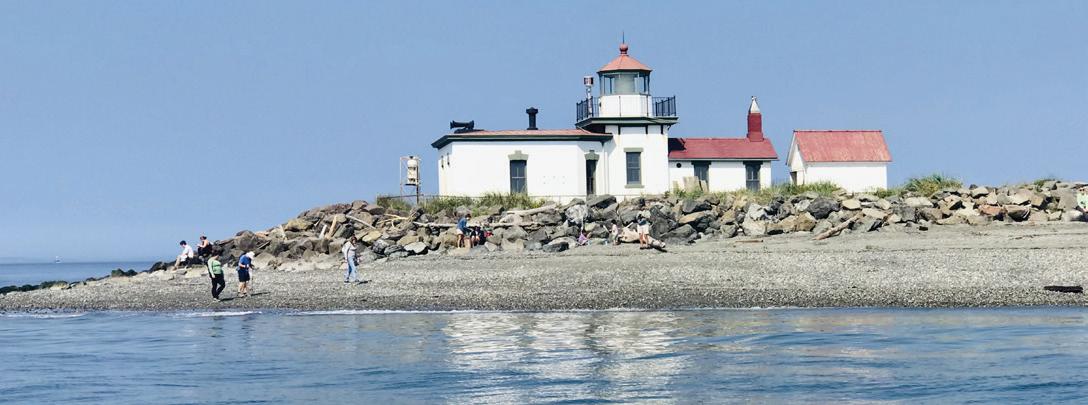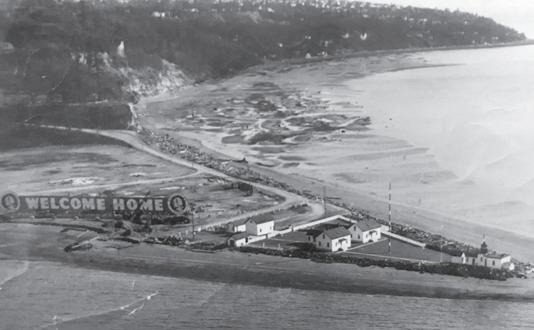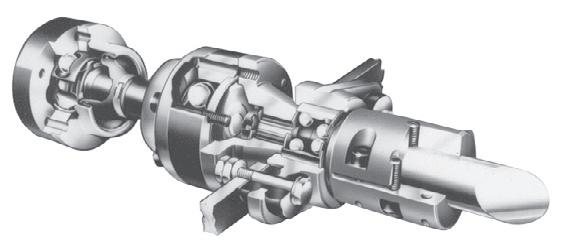
6 minute read
Beacon Background: The West Point Lighthouse
24 BEACON BACKGROUND
by Lisa Mighetto
THE WEST POINT LIGHTHOUSE
The West Point Light has guided mariners in and out of Seattle since 1881. This small but stately beacon sits on a low sandy point at the northern entrance of Elliott Bay, overlooking the busiest vessel traffic in Washington waters. An endless stream of freighters, ferries, cruise ships, tugs, fishing boats, and recreational craft pass this icon on a daily basis. Given the proximity to Seattle, it is difficult today to imagine why many early accounts described the location as “lonely” and “isolated.”
The Duwamish, Suquamish, Tulalip, and Muckleshoot nations have used this place since time immemorial, gathering abundant sea life from its shore and meeting and trading here. The original name for the point, which extends into Puget Sound from what is now Magnolia Bluff, is PKa’dz Eltue, meaning “thrusts far out.” Lieutenant Charles Wilkes renamed the site “West Point” in 1841 during his Exploring Expedition through Puget Sound.
THE LIGHT STATION
In 1879 the Lighthouse Board noted the need for a navigation aid at the “first prominent point or sand-spit north of the busy town of Seattle,” and construction began soon after. The Lighthouse Board recognized the potential for shipping along this “magnificent sheet of water, which has not its equal in the world,” hoping that fog signals would allow continuous navigation “without danger to life and property” (Annual Report of the Light-House Board of the United States, 1879).
The station at West Point included a square brick tower covered in stucco. Measuring 23 feet tall, it sat at the outer end of the spit. The lantern room, octagonal in shape, featured a fourth-order Fresnel lens manufactured in Paris — typically used to mark shoals, reefs, and harbor entrances. A weight that descended through a 13-foot drop tube propelled the lens, and had to be wound every two-and-a-half hours. Illumination came from a kerosine lamp. The light revolved once every two minutes to produce red and white flashes, spaced by 10 seconds. It began operating in November 1881, just in time for heavy weather.
A 1,600-pound fog bell was added to the rear of the lighthouse. This device was relocated from Cape Disappointment, where it had been in service since 1856. The bell proved difficult for mariners to hear, however, and was soon replaced with a steam whistle. In 1906, the Lighthouse Service installed a Daboil trumpet fog signal operated by compressed air passing across a vibrating reed, powered by diesel engines. A brick structure attached to the west side of the light tower housed the device, which included a trumpet extending through the wall to project the sound. The new fog signal produced a 3-second blast every thirty seconds. Today, mariners can key their radio mic five times on channel 81A to activate the station’s foghorn, which will remain in operation for 30 minutes.
The keepers’ quarters were located behind the lighthouse in a less exposed spot farther inland, and included a five-room frame wood cottage constructed in a Cape Cod style. Electricity did not reach the station until 1926, and during the early years there was no road along the sandy spit or the edge of Magnolia Bluff. For several decades, the light station remained secluded. “It might be that the lighthouse was on an island in the Pacific,” wrote one visitor, “so completely shut in does it seem from the world.” Yet Seattle, “a large city, whose hills are covered with dwellings,” sat nearby (Seattle Post-Intelligencer, Jan. 28, 1906).
THE KEEPERS
George T. Fonda was the longest serving head keeper at the West Point Light. Described as a “hale and hearty” man “seasoned with salt spray,” he contended with the consequences of thick fog and “roaring southwest gales” for nearly 25 years at the station. The light and the fog signal required daily maintenance and monitoring. Even so, ships collided, ran aground, and caught fire off West Point — and keepers were there to assist.
One year, a persistent storm swept over the sandy spit. The pounding waves and fierce wind undermined the foundation of
the station, and Fonda found it “impossible to enter the watch room, as the steps were torn away and a gaping hole made under the building.” So severe was the damage that Fonda had to carry his wife on his back over the water, where she crawled into a lighthouse window and was able “to trim the light and keep it burning through the lonely darkness of the night” (Seattle Post-Intelligencer, Jan. 28, 1906).
Several events revealed the harsh conditions of lighthouse tending, particularly in winter. During Fonda’s tenure, for example, an assistant keeper found his wife dead on the beach at West Point in 1902. Initially reported as a suicide, her death was later portrayed as an accident resulting from her fainting on the sand before high tide. “She was not of a despondent nature,” the Seattle Post-Intelligencer suggested. “Her home life was happy, and her husband was most kind and indulgent” (Seattle Post-Intelligencer, Dec. 6, 1902). Whatever the cause of her death, it was clear that West Point could be dangerous. In 1913 Assistant Keeper James E. Shaw drowned on a December day when he fell out of an open powerboat while approaching the lighthouse with his wife and child on board. He had served for only a few months at the West Point Light.
Two years later, head keeper Louis A. Pettersen rescued a Ballard mill worker whose boat overturned in the icy waters off West Point. Hearing faint cries for help, Pettersen fought his way through a “violent sea” in a skiff too small for two people. The drowning man had to cling to the stern with numb fingers while Pettersen rowed the two of them to shore. Pettersen thus became a local hero under “thrilling circumstances” (Seattle Times, Dec. 19, 1915). The 1917 opening of the Lake Washington Ship Canal, located northeast of West Point, increased the number and variety of vessels passing the lighthouse.

THE LIGHTHOUSE TODAY
In 1985 West Point became the last light station in Washington to be automated. Today, it remains a functioning navigational aid and is part of Discovery Park, which also includes some of the buildings of Fort Lawton. The lighthouse is one of the most popular sites in the park, which is operated by Seattle Parks and Recreation. It continues to send out alternating red and white flashes, guiding mariners through one of the busiest and most scenic stretches of the Salish Sea. The West Point Lighthouse welcomed troops home after World War II. Photo courtesy of the US Coast Guard.
Lisa Mighetto is a historian and sailor living in Seattle. She is grateful to the Coast Guard Museum Northwest for providing images and information for this article.



Ships FREE Ground UPS!
INSTALL
5hp – 2000hp
Business or Pleasure, AquaDrive will make your boat smoother, quieter and vibration free.
The AquaDrive system solves a problem nearly a century old; the fact that marine engines are installed on soft engine mounts and attached almost rigidly to the propeller shaft.
The very logic of AquaDrive is inescapable. An engine that is vibrating on soft mounts needs total freedom of movement from its propshaft if noise and vibration are not to be transmitted to the hull. The AquaDrive provides just this freedom of movement. Tests proved that the AquaDrive with its softer engine mountings can reduce vibration by 95% and structure borne noise by 50% or more. For information, call Drivelines NW today.








